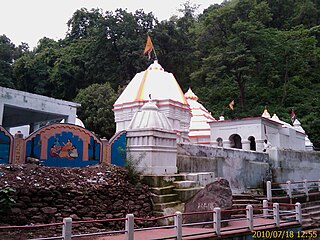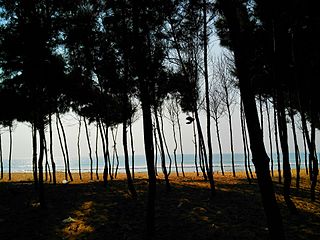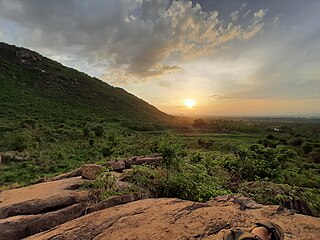
Ganeswarpur is an Indian village. The village falls under the Gop block of Puri District. It was founded before 1500 AD by Puri Gajapati Prataprudra Deva.

Bhadrak District is a district of Odisha state in eastern India. Bhadrak city is the headquarters and the largest city of the district.

Balangir District, also called Bolangir District, is a district situated in western Odisha state of India. The district has an area of 5,165 km2 (1,994 sq mi), and a population of 1,648,997. The town of Balangir is the district headquarters. The composition of the land is predominantly rural. Other important big & small towns in Balangir district are Titlagarh, Patnagarh, Kantabanji, Loisingha, Saintala, Belpada, Tushra, Agalpur, Deogaon, Chudapali, Biripali, Bhalumunda, Bangomunda, Sindhekela, Turekela and Muribahal.

Subarnapur, also known as Sonepur, is a town and district headquarters of Subarnapur district of Odisha. The district spreads over an area of 2284.89 km2. It is also known as Second Varanasi of India for its cluster of temples having architectural importance and also of tantricism and second Allahabad for the Meeting Point (Sangam) of three rivers Mahanadi, Tel and Sukhtel in place just like in Allahabad. Subarnapur is also famous for silk, handloom, prawns, terracotta etc.

Subarnapur District, also called Sonepur District or Sonapur District, is an administrative district in western Odisha state in eastern India. The town of Sonepur is the district headquarters. Sonepur has a rich cultural heritage and is known as the Mandiramalini town of Odisha with more than hundred temples. The people of the Sonepur region are referred to as Sonepuria.

Puri district is a coastal district of the Odisha state of India. It has one sub-division, 11 tahasils and 11 blocks and comprises 1722 revenue villages. Puri is the only municipality of the district. Konark, Pipili and Nimapara are the three NACs in this district. Satyabadi, Gop, Kakatpur and Brahmagiri are major semi-urban areas.

Boudh District is an administrative and a municipal district, one of the thirty in the Odisha, India. The district headquarters of the Boudh District is the city of Boudh.

Sambalpur is the fifth largest city in the Indian State of Odisha. It is located on the banks of river Mahanadi, with a population of 335,761 . Sambalpur is one of the ancient places of India, with recorded settlements in the prehistoric age. It is the home of Sambalpuri Saree from which the world famous textile derives its name.

Bellaguntha is a town and a Notified Area Council (N.A.C.) in Odisha, India. Which was the main market of South Odisha in the time of British India. Bellaguntha is also known as Brass Fish Town though the place is world famous for Brass Fish inventions.

Jatni is a town and a major sub-urban area of Bhubaneswar, the state capital of Odisha. It is also a municipality in Khordha district in the Indian state of Odisha. Jatni, also known as Khurda Road Junction in Indian Railways parlance, acts as an important railway junction between the main railroads running between Kolkata and Chennai, with diversions to the Hindu pilgrimage city of Puri, and to Balangir, passing through the districts of Nayagad, Daspalla, Phulbani, Boudh and Sonepur the vast tribal hinterland of Odisha. It has emerged as a commercial hub with a number of educational and other institutions. It is home to Premier Public Institutes like NISER and IIT-Bhubaneswar and ICAR- International Centre for Foot and Mouth Disease (ICFMD). Jatni is famous for its celebration of the festival of Ganesh Chaturthi.

Tarbha is a Notified Area Council in Sonepur district in the Indian state of Odisha.

Mukteshwara Temple is a 10th-century Hindu temple dedicated to Shiva located in Bhubaneswar, Odisha, India. The temple dates back to 950–975 CE and is a monument of importance in the study of the development of Hindu temples in Odisha. The stylistic development the Mukteswara marks the culmination of all earlier developments, and initiates a period of experiment which continues for an entire century, as seen in such temples as the Rajarani Temple and Lingaraj temple, both located in Bhubaneswar. It is one of the prominent tourist attractions of the city.
The Tel river flows in Nabarangpur, Kalahandi, Balangir, Sonepur District of Odisha, India. Tel is an important tributary of Mahanadi. It flows just eight kilometers away from the town of Titilagarh. This significant tributary of the Mahanadi river meets the main river at Sonepur or Subarnapur. The convergence of the two rivers offers a remarkable view against a colorful landscape. Baidyanath temple, which is famous for the Kosaleshwar Shiva temple, is located on the left bank of the Tel River.
The Indian state of Odisha has a rich cultural and artistic heritage. Due to the reign of many different rulers in the past, arts and crafts in Odisha underwent many changes giving an artistic diversity today in the forms of traditional handicrafts, painting and carving, dance and music.
Birmaharajpur is a subdivision town of Subarnapur district in the state of Odisha, India. Birmaharajpur Subdivisional Headquarter is the Birmaharajpur town. It is located 22 km towards east from district headquarter Sonepur. It is a dispersed town and located on the left bank of the river Mahanadi. It is located about 229 km from state capital Bhubaneswar.

A Sambalpuri sari is a traditional handwoven ikat or sari wherein the warp and the weft are tie-dyed before weaving. It is produced in the Sambalpur, Balangir, Bargarh, Boudh and Sonepur districts of Odisha, India. The sari is a traditional female garment in the Indian subcontinent consisting of a strip of unstitched cloth ranging from four to nine metres in length that is draped over the body in various styles.

Subarnameru Temple is situated in Sonepur town in Subarnapur district of Odisha, India.It is a shrine for the worshipping of Shiva and commonly known as Second Varanasi of India.

Patali Srikhetra is a famous place with significant historical importance for Subarnapur district and Odisha. This religious place is associated with Shaktism, Buddhism and Vaishnavism. It is located in the foot of Trikut Hill at Kotsamalai of the Birmaharajpur subdivision of Subarnapur district, Odisha, India. It widely believed that the idol of Lord Jagannath, Balabhadra and Devi Subhadra were kept hiding in the caves of the Trikut for a period of 144 years.
Odisha, an eastern Indian state on the Bay of Bengal, is known for its tribal cultures and its many ancient Hindu temples. Many small kingdoms, ruled by local chieftains, existed in ancient times, in what is now called Western Odisha.Western Odisha or the western part of Odisha, India, is extending from the Bolangir district in the south to the Sundargarh district in the north.

Odisha Ikat is a kind of ikat, a resist dyeing technique, originating from Indian state of Odisha, adapted from ikat in Indonesia. Also known as "Bandha of Odisha", it is a geographically tagged product of Odisha since 2007. It is made through a process of tie-dying the warp and weft threads to create the design on the loom prior to weaving. It is unlike any other ikat woven in the rest of the country because of its design process, which has been called "poetry on the loom". This design is in vogue only at the western and eastern regions of Odisha; similar designs are produced by community groups called the Bhulia, Kostha Asani, and Patara. The fabric gives a striking curvilinear appearance. Saris made out of this fabric feature bands of brocade in the borders and also at the ends, called anchal or pallu. Its forms are purposefully feathered, giving the edges a "hazy and fragile" appearance. Ikat's equivalent usage in Malay-Indonesian language is ikat or mengikat, which means "to tie or to bind".










